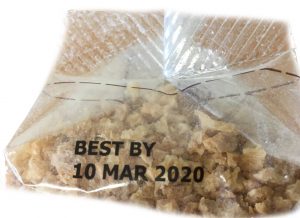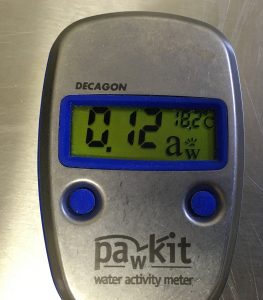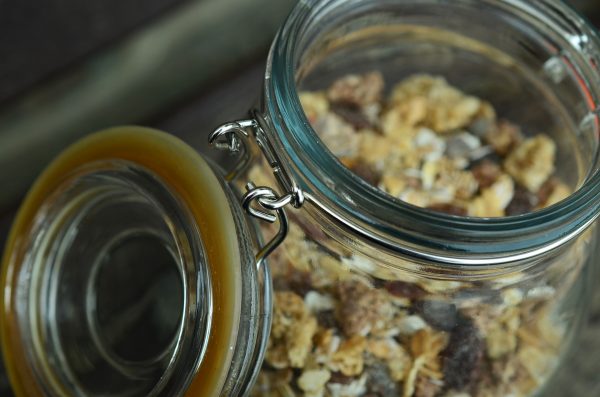Like all packaged foods, backpacking meals often contain a “Best By “date. If you happen to notice the food has exceeded this date, you may have thrown it out, even though it was likely fine to eat. According to this study, 85% of Americans will throw a food item away because of the misconception that a Best By date represents an Expire date.
That’s unfortunate because you are not merely wasting calories or money, but all the resources that went into producing the trail meal as well. Think of all the wasted inputs to make that packaged food exist and get into your hands — watering, growing, harvesting, drying, packaging, and transporting. Furthermore, if that food gets fed into the landfill (instead of your stomach), it generates greenhouse gases that contribute to atmospheric warming. So, think again before tossing food out!
Expired or Past Quality? Understanding Food Dates
 Except for baby formula, expiration dates are not required to be on packaged commercial food. These dates are added voluntarily by the manufacturer to help retailers and consumers identify when a food is at peak flavor.
Except for baby formula, expiration dates are not required to be on packaged commercial food. These dates are added voluntarily by the manufacturer to help retailers and consumers identify when a food is at peak flavor.
Here’s the official meaning of food dates from the USDA:
- “Best By/Before” designates when a product will have the best quality or flavor.
- “Sell By” date represents how long a store should display the product for sale.
- “Use By” designates the last recommended date for peak quality.
Notice that none of these dates are safety dates — unless it’s for infant formula. At Outdoor Herbivore, we use a Best By date on our packages, which is a quality indicator, not an expiration date. Food quality indicators such as staleness, luster, and aroma will deteriorate after this date, but it does not mean it is unsafe to eat.
Unless the food exhibits signs of spoilage, it is not harmful to eat.
To check if the food is still good to eat, open up the pouch and take a whiff. Does it smell fresh or musty? Spoiled foods will often taste slightly metallic or bitter and can produce a numbness or tingling sensation on the tongue. Keep in mind that some trail food products, such as meat jerky (we don’t sell this), can become unsafe if you eat them long after the intended quality date. One reason for that is because jerky is moist enough where halophilic bacteria, yeast, and molds can still grow. But more than likely, you will know it is bad because it will smell awful and the first bite will taste terrible. When in doubt, throw it out.
Therefore, the short answer to the question, “Can I eat commercially prepared trail food after the Best/Before/Sell/Use Date?” is most likely!
Presumably, you have left the packaging intact and keep it stored properly.
Moisture Content and Shelf Life
Food manufacturers must abide by specific standards to guarantee shelf life. This includes measuring the moisture content and water activity of food as well as

packaging and storage procedures. High levels of water activity allow the food to react with microorganisms and grow bacteria, yeast, and mold. Conversely, low levels of water activity prevent the growth of pathogens, and thus spoilage. Commercial packaging is designed to keep the dried food dry during storage by substantially reducing the transmission rate of moisture from the air.
Many backpackers tend to repackage dried meals in zipper sandwich bags to save on weight or space. Outdoor Herbivore advises against repackaging food pouches or waiting to do so before your hike. Otherwise, repacked food can become susceptible to spoilage.
We have a Storage Life for each product on our website to help you determine how long you can expect our meals to taste best before you make a purchase. Scroll down to the bottom of the product description to see it.
Remember to always store dry food in a cool and dry location. Storage temperatures should not exceed 85 F and should be stored in the original packaging right before you plan to eat them.

If you make trail food using a dehydrator or oven, make sure to dry it at the correct temperature and length of time according to the recipe guidelines. Store homemade trail food in mason jars or moisture barrier bags for best results. Food stored in standard zipper bags, including freezer bags, will reduce shelf life. Use them only for storing short-term (1 – 2 months).
Related Posts:
References
Food Product Dating. (2020). Fsis.usda.gov. Retrieved 22 February 2020, from https://www.fsis.usda.gov/wps/portal/fsis/topics/food-safety-education/get-answers/food-safety-fact-sheets/food-labeling/food-product-dating/food-product-dating
Jerky and Food Safety. (2020). Fsis.usda.gov. Retrieved 22 February 2020, from https://www.fsis.usda.gov/wps/portal/fsis/topics/food-safety-education/get-answers/food-safety-fact-sheets/meat-preparation/jerky-and-food-safety/
One thought on “Can I Eat Outdoor Herbivore after the Expiration Date?”
I always end up throwing away so much food, that is until i started learning that I don’t have to just based on the expiration date. I had some spinach that was 2 weeks passed the expiration date and it was perfectly fine! I think it should be a sniff and taste test before throwing stuff out. I read more about it here, https://www.ez.insure/landing/2021/06/use-by-sell-by-best-by-do-expirations-dates-matter/ It had some great points, and hopefully more people dig into this so they can waste less food.